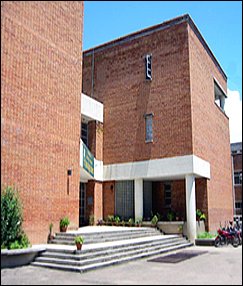 Maharajgunj
Campus (MC) at Maharajgunj, Kathmandu is one of the nine campuses of
the Institute of Medicine (IoM). Since its upgradation to the status
of a campus of IoM from the Auxiliary Health Worker's School in 1972,
MC has, during the span of just over two decades, played a significant
role in conducting academic programmes for the development of different
categories of Human Resources for Health (HRH) in Nepal. Of the twenty-nine
academic programmes that the IoM runs to date, twenty-five consisting
of eighteen postgraduate, four undergraduate and three certificate programmes
(about ninty percent of the educational activities of the IoM) are being
conducted at MC. In its endeavour to create competent and diverse Human
Resources for Health. HRH, ranging from a Primary health Care worker
to a Medical Specialist for rendering primary to tertiary health care
in the country. MC has indeed taken a long stride in the field of medical
education in Nepal.
Maharajgunj
Campus (MC) at Maharajgunj, Kathmandu is one of the nine campuses of
the Institute of Medicine (IoM). Since its upgradation to the status
of a campus of IoM from the Auxiliary Health Worker's School in 1972,
MC has, during the span of just over two decades, played a significant
role in conducting academic programmes for the development of different
categories of Human Resources for Health (HRH) in Nepal. Of the twenty-nine
academic programmes that the IoM runs to date, twenty-five consisting
of eighteen postgraduate, four undergraduate and three certificate programmes
(about ninty percent of the educational activities of the IoM) are being
conducted at MC. In its endeavour to create competent and diverse Human
Resources for Health. HRH, ranging from a Primary health Care worker
to a Medical Specialist for rendering primary to tertiary health care
in the country. MC has indeed taken a long stride in the field of medical
education in Nepal.
The establishment
of Tribhuvan University Teaching Hospital (TUTH) in 1983 near to MC
premise, made the fact very clear imparting medical education does require
a teaching hosital for facilitating teaching-learning activities effectively.
With the establishment of TUTH, MC acquired the full status of the First
Medical School in Nepal. Since then, MC not only became responsible
for imparting medical education but also started to provide tertiary
health care to all those coming to THTH. The faculty of medicine here
played a dual role- that of a medical teacher and a medical specialist.
Institutional
Objectives::
In its endeavour
to fulfilling country's need of Human Resources for Health an research
undertakings, MC in association with TUTH and accordance with the HMG
New Education Act 1993 (2050), has the following overall institutional
objectives:
- To undertake
undergraduate and postgraduate medical education to create generalist
and specialist medical professionals.
- To train human
resources for health in allied health sciences.
- To deliver preventive,
curative, promotional and rehabilitiative health care.
- To conduct educational
and biomedico-social research.
- To implement
continuing education for Human Resources for Health.
- To establish
academic linkage with international medical schools/colleges/universities.
Future::
It has been felt
that Maharajgunj Campus (MC) of the IOM, after having served the nation
for over two decades, must concentrate on tertiary education under the
academic guidelines set by the HMG and promulgated by the Ministry of
Education in 1993. As a result, MC has stopped many of its programmes
and acquired newer sets of roles and responsibilities brought about
by the changes in the global prespective in general and societal needs
in Nepal in particular. If this twentieth century needs to pass on legacy
to its future, changes in role and responsibilities of MC become inevitable
and calls for thinking globally while acting locally in order to herald
medical education that will be appropriate for the twenty-first century.
Certificate programmes
being conducted at MC are after 12 years of formal education and are
in the hospotal-related areas of Health Laboratory, Pharmacy and Radiography.
A bachelor course in Optometry was started in 1997.
MC now runs the
MBBS programme as its main academic programme; it will gradually undertake
other specific undergraduate and postgraduate programmes from its departmental
level.
Looking ahead towrads
the future, MC aims to achieve self-reliance in the production of medical
and allied health science graduates and postgraduates in different specialities
of medical seiences to fulfill the demand of Human Resources for Health
in the country.

